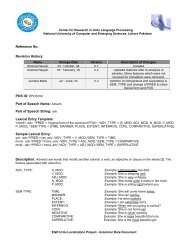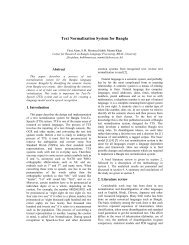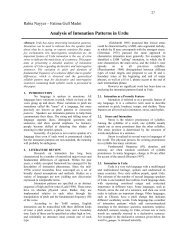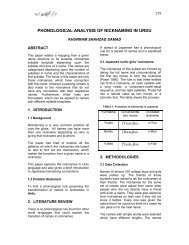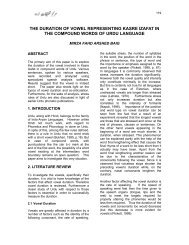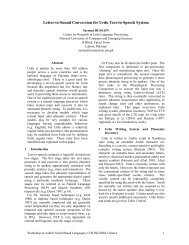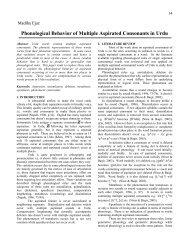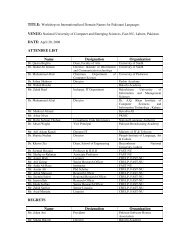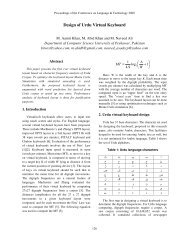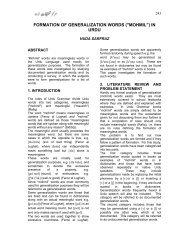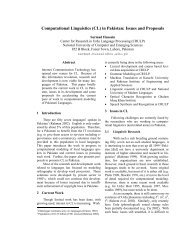SYLLABLE TEMPLATES IN URDU LANGUAGE - Center for ...
SYLLABLE TEMPLATES IN URDU LANGUAGE - Center for ...
SYLLABLE TEMPLATES IN URDU LANGUAGE - Center for ...
Create successful ePaper yourself
Turn your PDF publications into a flip-book with our unique Google optimized e-Paper software.
192<br />
<strong>Center</strong> <strong>for</strong> Research in Urdu Language Processing<br />
As in any language, there are some Urdu<br />
letters that are more popular or frequent<br />
than others in serving as the start of the<br />
word. The selection of the words aimed to<br />
provide equal representation to the words<br />
with the lower frequency and higher<br />
frequency. The number of words in the<br />
dictionary were listed down in descending<br />
order of starting-letter-frequency, indicated<br />
by the number of pages devoted to each<br />
alphabet. The words to be analyzed were<br />
then chosen alternately from the beginning<br />
and ending of this list. The reasoning behind<br />
this procedure is the assumption that if there<br />
are less number of words with a particular<br />
letter in the starting position than another,<br />
then there may some constraint upon its<br />
<strong>for</strong>mation that rejects most of the<br />
possibilities. Hence an investigation of the<br />
high frequency words alone may not<br />
elucidate this constraint. However, the high<br />
frequency words themselves represent a<br />
more generous constraint and there<strong>for</strong>e<br />
must not be completely ignored. An equal<br />
representation of both classes seemed the<br />
best choice and was adopted.<br />
Another important consideration was the<br />
unbiased analysis of the structure of<br />
syllable. Since a native speaker of the<br />
language is best qualified to render<br />
judgement in this case, the analysis was<br />
based on the judgement of such a speaker,<br />
which in this case is the author himself.<br />
There is no standard transcription of Urdu<br />
words available, hence, care was necessary<br />
to avoid the bias that would have crept in<br />
had the author first transcribed the word and<br />
then attempted to analyze it. That is<br />
because the <strong>for</strong>mal phonological training of<br />
the author would have come into play, in<br />
following the rules of syllabification and then<br />
making out syllables instead of judging the<br />
syllables from the spoken word and then<br />
figuring out their inherent templatic structure.<br />
There<strong>for</strong>e, the words of Urdu from the<br />
dictionary were not transcribed, to obtain the<br />
best-unbiased data.<br />
Another important aspect of the selection of<br />
words was to discriminate between the<br />
words of Urdu as opposed to those with a<br />
distinctly English origin. The reasons <strong>for</strong> this<br />
are given in the Discussion section.<br />
4. RESULTS<br />
The study reveals the following syllable<br />
templates of Urdu, listed in order of<br />
descending percentage frequency.<br />
CVV 39<br />
CVC 20<br />
CVVC 15<br />
CV 17<br />
CVCC 3.2<br />
VV 2.5<br />
VVC 1.5<br />
VC 1.0<br />
CVVCC 0.3<br />
V 0.4<br />
VCC 0.05<br />
As mentioned earlier, the syllable structure<br />
was based upon the judgement of a native<br />
speaker and the source upon which the<br />
investigation was based is "Feroz-ul-Lughat<br />
Jaibi(ref).<br />
5. DISCUSSION<br />
Urdu makes use of both short and long<br />
vowels, where the short vowels are denoted<br />
by diacritical marks and the long ones by<br />
special alphabets in script. It is there<strong>for</strong>e<br />
instructive to rearrange the given templates<br />
into two groups based upon the length of the<br />
vowel.<br />
CVV 39 CV 17<br />
CVVC 15 CVC 20<br />
CVVCC 0.3 CVCC 3.2<br />
VV 2.5 V 0.4<br />
VVC 1.5 VC 1.0<br />
VCC 0.05<br />
Each group is represented almost wholly by<br />
its first two members in terms of percentage<br />
frequency volume. There<strong>for</strong>e it seems that a<br />
simple onset of one consonant, followed by<br />
a short or a long vowel, optionally followed<br />
by a simple coda of one consonant, i.e.<br />
CV(V)(C) is the makeup of the most natural<br />
syllable in Urdu.<br />
Urdu language does not license a short<br />
vowel in word final position. That is, the (C)V<br />
template can never be at the end of a word.



